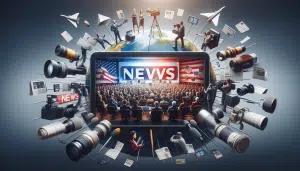Media Literacy Skills You May Be Missing
Lily Carter September 25, 2025
Discover why media literacy matters more than ever as digital news accelerates. This guide explores practical ways to decode headlines, spot misinformation, and build critical thinking skills to confidently navigate today’s fast-shifting media world.
Understanding Today’s Dynamic Media Landscape
Media channels have multiplied at an astonishing pace. Gone are the days of waiting for the evening news — updates now arrive in real time via digital outlets, social media, podcasts, and news aggregators. This sheer volume of information makes staying informed easier, but it also amplifies the spread of news that may be misleading or incomplete. With so much noise, accurately understanding current events can feel overwhelming. Media literacy provides the foundation for making sense of it all and helps people distinguish between reliable news and content that may be designed to provoke, manipulate, or distract.
Streaming platforms, digital journalism, and instant notifications have redefined the way global stories are consumed. Individuals now curate their own news feeds based on interests, geography, and previous habits. The rise of algorithms in social media and news aggregators means that not everyone receives the same version of a breaking news story. As a result, echo chambers form, leading to polarization or skewed worldviews. Understanding how algorithms affect what people see online is a key part of media literacy, helping audiences purposely diversify their news sources for a fuller picture.
Learning to interpret, analyze, and evaluate digital information is not just a trend but a vital skill. Experts recommend cultivating habits such as questioning sources, cross-checking stories, and examining the context behind viral headlines. Ultimately, news engagement today depends not only on access but on the ability to critically interact with the stories presented. Whether on a mobile screen or in a morning newspaper, every reader faces the task of sifting truth from spin — and that begins with media literacy.
Spotting Misinformation and Disinformation
The prevalence of misinformation in the digital age is a growing concern. Sources can look legitimate, yet contain inaccuracies or outright falsehoods designed to mislead or incite. Disinformation — information spread deliberately to deceive — has severe impacts on public trust and decision-making. From manipulated images to false viral claims, individuals are exposed to an increasing volume of potentially harmful content. Fact-checking habits, supported by reputable fact-checking organizations, are essential for confirming details and perspectives within rapidly evolving news cycles.
Understanding the motives behind misinformation campaigns is equally important. Some sources prioritize sensationalism or ad revenue over journalistic integrity, while others aim to influence political outcomes or erode trust in institutions. Recognizing classic warning signs — such as emotionally charged language, lack of attribution, or suspicious URLs — can help audiences pause before sharing or reacting to questionable information. Media literacy encourages the development of a healthy skepticism, but not cynicism, leading to more informed civic participation.
Multiple studies highlight that misinformation spreads faster than corrections do. Therefore, building resilience requires more than casual reading. Developing skills to trace claims back to their original context and to compare them with trustworthy reports is critical. Various organizations provide digital media literacy tools that guide users through such processes, teaching individuals to slow down and verify news before passing it on. This method minimizes the reach of inaccurate stories while helping communities stay grounded in evidence-based reporting.
Developing Critical Thinking for News Consumption
News literacy is closely tied to the art of critical thinking. At its core, this means asking probing questions, considering multiple perspectives, and avoiding snap judgments based on initial impressions. Rather than accepting headlines at face value, critical readers dig deeper, seeking context, potential biases, and alternative viewpoints. Skills in critical evaluation empower audiences to navigate controversial issues more objectively, separating facts from interpretations or opinion. This facilitates informed conversations and more balanced perspectives on current affairs.
Critical thinking also entails seeking primary sources whenever possible. Firsthand accounts, official statements, and data published by recognized institutions often offer the backbone of reliable reporting. Readers who use direct sources can compare coverage across various outlets, weighing differences in framing or emphasis. This habit not only broadens understanding but reduces vulnerability to distortion. Leading educators advocate for teaching critical evaluation from an early age, helping new generations approach news as active investigators, not passive recipients.
Applying critical reasoning extends well beyond spotting errors; it enables proactive engagement with societal debates. For example, when a controversial topic arises, consider how different stakeholders are represented, what questions go unasked, and what evidence supports or challenges the narrative presented. Practiced critical thinkers are less likely to fall prey to manipulation. Analytical mindsets are a safeguard against quick conclusions or groupthink, enabling a more resilient approach to consuming headlines in a polarized world.
Evaluating News Sources and Journalistic Integrity
The credibility of news outlets varies considerably. While some maintain rigorous editorial standards, others may bend facts to fit an agenda. Reliable journalism is usually transparent about its sources, methodology, and corrections. Reputable news organizations disclose conflicts of interest, clarify when information is opinion versus fact, and maintain an archive of retractions. Understanding how to assess the credibility of both mainstream and alternative sources allows consumers to form well-founded opinions on current events, as opposed to relying solely on the most accessible or shocking update.
Some practical ways to assess journalistic standards include checking for bylines, researching the publication’s track record, and looking for corroboration from other respected outlets. Watch for “about” pages that clearly define editorial processes and fact-checking routines. Pay attention to diversity in reporting: does the news site reflect a range of contributors, locations, and expertise? Outlets that present balanced viewpoints and allow for healthy debate are generally considered more trustworthy than those with a single, unchallenged narrative thread.
International news organizations and nonprofit watchdogs play a role in monitoring press ethics globally. Many offer up-to-date reports on media bias, freedom of press, and the veracity of trending stories. Engagement with these platforms enhances an understanding of journalistic principles and supports more informed choices about what to read, trust, and share. News reliability is never static; readers benefit from ongoing self-education about the shifting standards and expectations of journalistic integrity in a complex digital world.
Practical Steps for Strengthening Your Media Literacy
Building strong media literacy skills begins with intentional habits. One of the most effective steps is curating a diverse mix of news sources. Regularly reading outlets with varying editorial leanings encourages perspective-taking and highlights how framing can affect the presentation of information. Subscribing to media literacy newsletters or following digital education programs provides bite-sized lessons on evaluating evidence, source credibility, and information context. These tools help readers remain agile and analytical as news cycles evolve.
Using open-source fact-checking platforms and media bias charts can also sharpen discernment. These tools allow individuals to compare coverage of the same event across different outlets, surfacing potential gaps or inconsistencies. Some even visually map out news ecosystems by transparency or reliability. Participating in online forums or moderated discussion groups around current events can build collaborative skills, fostering dialogue rather than confrontation. Engaging with media literacy initiatives from universities or public institutions enhances confidence in daily news interactions.
Media literacy isn’t achieved overnight — it requires ongoing practice and openness to change. The pace of news, the introduction of new platforms, and the innovations in information delivery mean that learning must be continuous. Participating in community workshops, taking reputable online courses, or leveraging guides from journalism nonprofits can provide ongoing structure. As media environments grow more complex, resilient news consumers lean on a foundation of habits: question, verify, consider context, and discuss with others. Staying ahead means staying curious and informed.
Benefits and Broader Impacts of Media Literacy
Societies benefit collectively when populations are media literate. Reliable news consumption fosters democratic participation, informed voting, and community resilience in times of crisis. Well-developed media literacy counters the spread of misinformation, minimizes panic during emergencies, and encourages open yet evidence-based dialogue. Advocates highlight the link between civic engagement and the ability to critically assess reported news — a vital ingredient for healthy societies, vibrant debate, and problem-solving in both local and global contexts.
At the personal level, improved media literacy can reduce stress and confusion caused by sensational headlines or rapid-fire updates. Individuals who are skilled at evaluating sources and recognizing bias are less likely to fall prey to the anxieties generated by misinformation, rumor cycles, or targeted disinformation. Critical consumers can engage in calm, productive discourse even when stories are controversial or developing. Over time, this personal resilience can ripple outward, strengthening entire networks of friends, colleagues, and families.
The broader impact of media literacy extends into education, work, and public life. Schools, universities, and workplaces that incorporate media analysis skills prepare their members for complex information landscapes. Students become more independent thinkers, employees make better-informed decisions, and professionals are less susceptible to industry-specific rumors or manipulative marketing. Ultimately, a commitment to media literacy is a commitment to collective truth-seeking, transparency, and trust — cornerstones for a fair and sustainable future story.
References
1. National Association for Media Literacy Education. (n.d.). Media Literacy Defined. Retrieved from https://namle.net/publications/media-literacy-definitions/
2. Pew Research Center. (n.d.). Trust and Distrust in America. Retrieved from https://www.pewresearch.org/politics/2019/07/22/trust-and-distrust-in-america/
3. UNESCO. (n.d.). Media and Information Literacy. Retrieved from https://en.unesco.org/themes/media-and-information-literacy
4. The News Literacy Project. (n.d.). How to Know What to Trust. Retrieved from https://newslit.org/educators/resources-for-teaching-news-literacy/
5. International Federation of Library Associations and Institutions. (n.d.). How to Spot Fake News. Retrieved from https://www.ifla.org/publications/node/11174
6. Stanford History Education Group. (n.d.). Evaluating Information: The Cornerstone of Civic Online Reasoning. Retrieved from https://cor.stanford.edu/curriculum/







